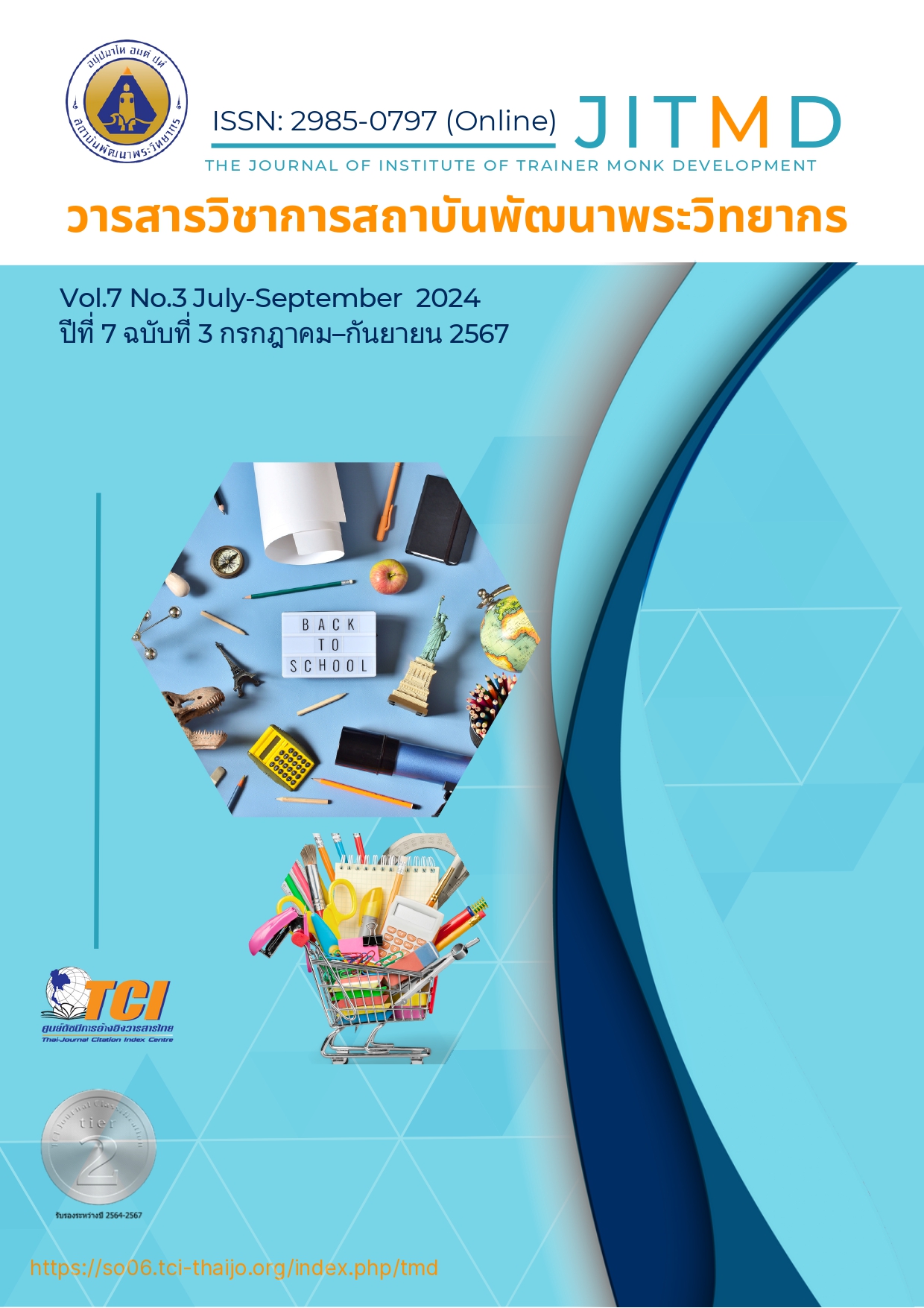A Study of Implementing of The Needs Learning Loss Measures in Schools Under the Supervision of the Saraburi Primary Educational Service Area Office 1
Main Article Content
Abstract
The objectives of this research article are to 1) study the current conditions and desired conditions of the implementation of measures to reverse the learning recession in educational institutions. Under the jurisdiction of the Saraburi Primary Educational Service Area Office, Area 1 2) Study the needs in implementing measures to revive the learning recession in educational institutions. Under the jurisdiction of the Saraburi Primary Educational Service Area Office, Area 1, the research sample numbered 290 people, with the proportion determined to be 44 administrators and 246 teachers. The tool used to collect this data was a 5-level rating scale questionnaire with content validity between 0.60 - 1.00 and a confidence value of 0.986. Statistics used in data analysis included: Frequency distribution, percentage, average, prioritization of needs (Priority Need Index: PNI) and content analysis (content analysis) by writing a description. The results of the study found that: 1. Current condition and desired condition in 7 measures according to the opinions of school administrators found that: 1.1 The overall current condition is at a high level. When considering each aspect by arranging the average values from highest to lowest, the first two are: Measure 5: Creating a good attitude towards learning and good health of learners, both physical and mental health. Measure 2: Providing welfare. Safety and Morale, 1.2 Overall desirable conditions are at a high level. When considering each aspect by average level from highest to lowest, the first two are: Measure 5: Create a positive attitude towards learning and good health of learners, both physical and mental health. Measure 2: Provide safety welfare and create morale 2. Overall needs. It was found that the top 3 areas with highest to lowest needs were: Measure 6: Upgrading learning management by using technology in a systematic and efficient manner. Measure 2: Empowering development. Teachers and educational institution administrators.
Article Details

This work is licensed under a Creative Commons Attribution-NonCommercial-NoDerivatives 4.0 International License.
บทความที่ได้รับการตีพิมพ์เป็นลิขสิทธิ์ของวารสารวิชาการสถาบันพัฒนาพระวิทยากร
ข้อความที่ปรากฎอยู่ในบทความที่ได้รับการตีพิมพ์ในวารสาร ถือเป็นความรับผิดชอบของผู้เขียนบทความ และข้อคิดเห็นนั้นไม่ถือว่าเป็นทัศนะและความรับผิดชอบของกองบรรณาธิการวารสารวิชาการสถาบันพัฒนาพระวิทยากร
References
กระทรวงศึกษาธิการ. (2565). มาตรการฟื้นฟูภาวะถดถอยทางการเรียนรู้. กรุงเทพฯ: สำนักพิมพ์วัฒนาพานิช จำกัด.
นรรธพร จันทร์เฉลี่ย. (2564). บทสัมภาษณ์ เรื่องภาวะความรู้ถดถอย (Learning Loss). สืบค้นข้อมูลเมื่อ 2 ธันวาคม 2565 จาก https://www.starfishlabz.com/blog/601/
เพ็ญสุดา ฤทธิ์มนตรี และวิเชียร รู้ยืนยง. (2562). กลยุทธ์การเสริมสร้างทักษะภาวะผู้นำในศตวรรษที่ 21 ของผู้บริหารสถานศึกษา สังกัดสำนักงานเขตพื้นที่การศึกษามัธยมศึกษาในภาคตะวันออกเฉียงเหนือ. วารสารบัณฑิตศึกษามหาจุฬาขอนแก่น, 6(4): 83-96.
รัตนมน เกษจุฬาศรีโรจน์. (2562). การศึกษากระบวนการพัฒนาการเรียนรู้ทางอารมณ์และสังคมสำหรับเด็กในช่วงรอยเชื่อมต่อทางการศึกษาจากชั้นเรียนอนุบาลสู่ชั้นเรียนประถมศึกษาปีที่ 1. ปริญญาครุศาสตร์มหาบัณฑิต ภาควิชาหลักสูตรและการสอน. คณะครุศาสตร์. จุฬาลงกรณ์มหาวิทยาลัย.
รัตนา กาญจนพันธุ์. (2563). คุณลักษณะที่พึงประสงค์ของผู้บริหารสถานศึกษาในศตวรรษที่ 21 ตามการรับรู้ของ ครูในโรงเรียนเครือสหวิทยาเขตเมืองปราการ จังหวัดสมุทรปราการ. Joumal of Roi Kaensarn Acadeni, 6(5): 94-101.
สถาบันวิจัยเพื่อความเสมอภาคทางการศึกษา. (2565). องค์ความรู้และเทคโนโลยีสารสนเทศ. สืบค้นข้อมูลเมื่อ 20 สิงหาคม 256 จาก https://www.eef.or.th/our-work/research-institute/
สำนักงานเลขาธิการสภาการศึกษา. (2565). การแพร่ระบาดของโรคติดเชื้อไวรัสโคโรน่า 2019. กรุงเทพฯ: สำนักงานเลขาธิการสภาการศึกษา.
เอกฤทัย ชัยลิ้นฟ้า. (2566). กลยุทธ์การจัดการเรียนรู้วิถีชีวิตใหม่ สำหรับสถานศึกษา สังกัดสำนักงานเขตพื้นที่การศึกษาประถมศึกษามหาสารคาม เขต 2. วิทยานิพนธ์ปริญญาการศึกษามหาบัณฑิต สาขาวิชาการบริหารและพัฒนาการศึกษา. มหาวิทยาลัยมหาสารคาม.
Hoy, Wayne K. and Cecil G, Miskel. (2001). Educational Administration: Theory, Research and Practice. 6 th ed. Mc Graw – Hill International Edition 2001
Nair. (2007). Schools for the 21st century: Are you ready. Searched on 21.


